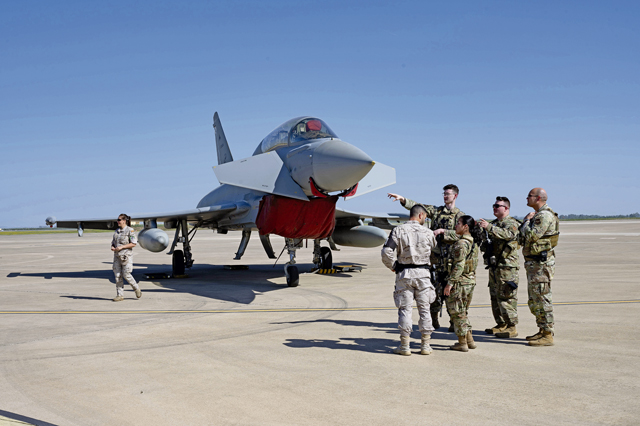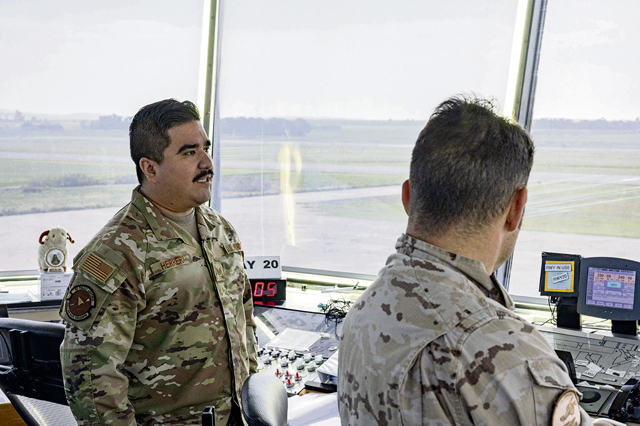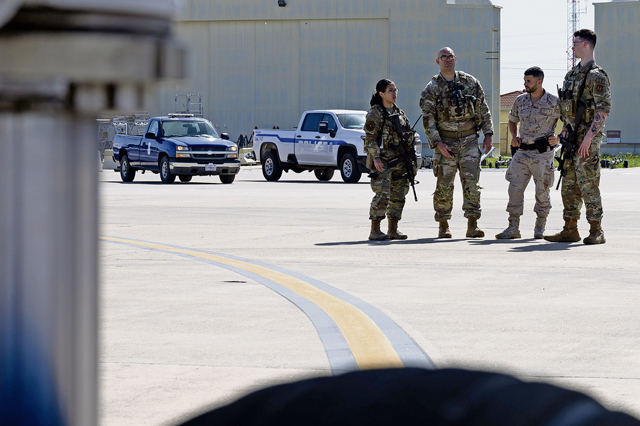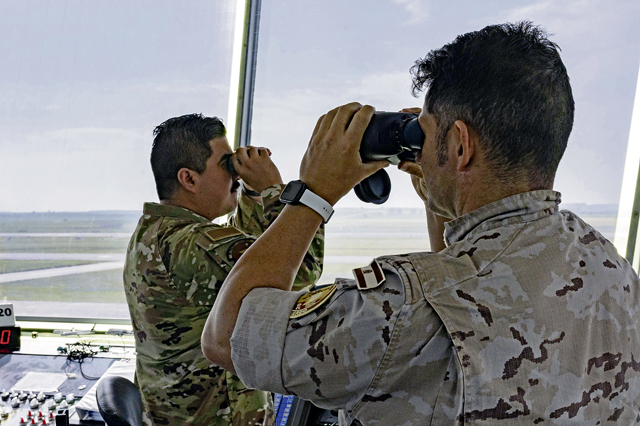
In the springtime of southern Spain, long roads reach out into the distance beneath bright blue skies with the fresh scent of olives swirling in the breeze. Scenic views of neatly arranged olive tree groves span beyond the horizon. On a bridge above route A-360, a shepherd guides sheep safely over the road. Further down A-360, tucked in the countryside about 40 minutes southeast of Sevilla, is Morón Air Base, home to a strong and flourishing bond between the Spanish and American air forces.
The ability of U.S. forces to integrate and operate in conjunction with Spain is critical to bolstering a relationship capable of swiftly and decisively meeting any potential challenge at Morón AB and across the globe.
“Relationships are a cornerstone of our national security strategy and emphasized at every level down, to include our squadron’s vision,” said U.S. Air Force Lt. Col. Christopher E. K. Curry, 496th Air Base Squadron commander. “Navigating relationships between nations is complex, but is ultimately a force multiplier to achieve common goals based on shared values and a safer world.”

Several flights within the 496th ABS on Morón AB have benefited from bilateral integration efforts, most evidently seen through the successes of security forces, fire and emergency services, and air traffic control personnel.
While the 496th ABS Security Forces Flight makes up nearly one-third of the active duty U.S. presence on Morón AB, training with their Spanish security forces counterparts has proven beneficial to their efficiency, strategies and planning, said Tech. Sgt. Gregory Pfeiler, 496th ABS Security Forces defender. “We train a lot and we train frequently, so knowing what resources our partners are able to offer is a big key in developing our training plans,” he added.
Recently, both USAF Airmen and Spanish air force security forces personnel demonstrated an additional benefit of bilateral integration through their completion of the first-ever combined active shooter training exercise at Morón AB.

“The Spanish already had standard operating procedures for locking down the affected area, which enabled us to effectively dispatch and control any kind of situation in the area immediately,” Pfeiler said. “We had direct, instant communication. Thanks to the Spanish, we are 100 percent stronger together.”
Both U.S. and Spanish security forces now practice together, training like they fight, and have permanently implemented combined patrols. In the command center, U.S. Airmen and Spanish defenders sit side-by-side responding to calls.
An integrated training initiative at Morón AB with the two nation’s fire department personnel has also been mutually beneficial.

Scott Zrakovi, 496th ABS fire and emergency services chief, met with his Spanish air force fire chief counterpart to revitalize an old agreement that allowed the two departments to work together. Since then, U.S. and Spanish fire and emergency services departments have held combined training sessions to teach each other about various equipment unique to their operations, and to learn each department’s capabilities during a crisis situation.
“The more resources you can put towards a specific incident, the quicker it can be contained and we can deliver a more powerful response,” said Michael Barry, 496th ABS fire and emergency services assistant chief. “The more firefighters, water and resources available keeps everyone on base safer.”
Combining forces and sharing training plans and strategies has allowed both security forces and fire and emergency services to streamline processes, and learn how they can work together to grow and perform as one unit.
Similarly, USAF air traffic controllers also combine their forces, train together and share standards to enhance their operations in the air traffic control tower. The controllers’ unified efforts allow Airmen to assist the Spanish air force controllers when needed while strengthening their own capacity to perform.
“We provide any additional support they may need with Spanish Eurofighters and when other NATO aircraft come in,” said Staff Sgt. Arturo Herrera, 496th ABS Operational Support Team tower watch supervisor. “We adhere to USAF and Federal Aviation Administration rules with our Department of Defense assigned aircraft. However, with NATO and host nation aircraft, we can provide that support because we get trained under their standards and we are qualified to work their air traffic too.”
In an effort to meet Spanish standards and operating procedures, USAF air traffic controllers assigned to the 496th ABS are required to attend the Defense Language Institute Foreign Language Center for Spanish before arriving at Morón AB. These Airmen also must complete continued language studies to remain fluent and increase their ability to communicate effectively with the host nation. These efforts also aid in fostering the working relationships they have formed with the Spanish forces.
“These relationships have been built on a foundation of good rapport, which allows us to establish trust,” Herrera said. “The trust we build here helps us accomplish our mission.”
With increased bilateral training, U.S. Airmen at Morón AB are able to learn systems, equipment, processes, and tactics Allies offer to improve effectiveness and interoperability in various geographic areas.
“Collaboration between the USAF and Spanish air and space force at Morón is at an all-time high,” Curry said. “This extends to our relationships with the Office of Defense Cooperation, Defense Attache Office, and the U.S.-Spain Permanent Committee in Madrid. These partnerships enable us to move out quickly on initiatives to address critical mission needs in a rapidly changing global environment.”


